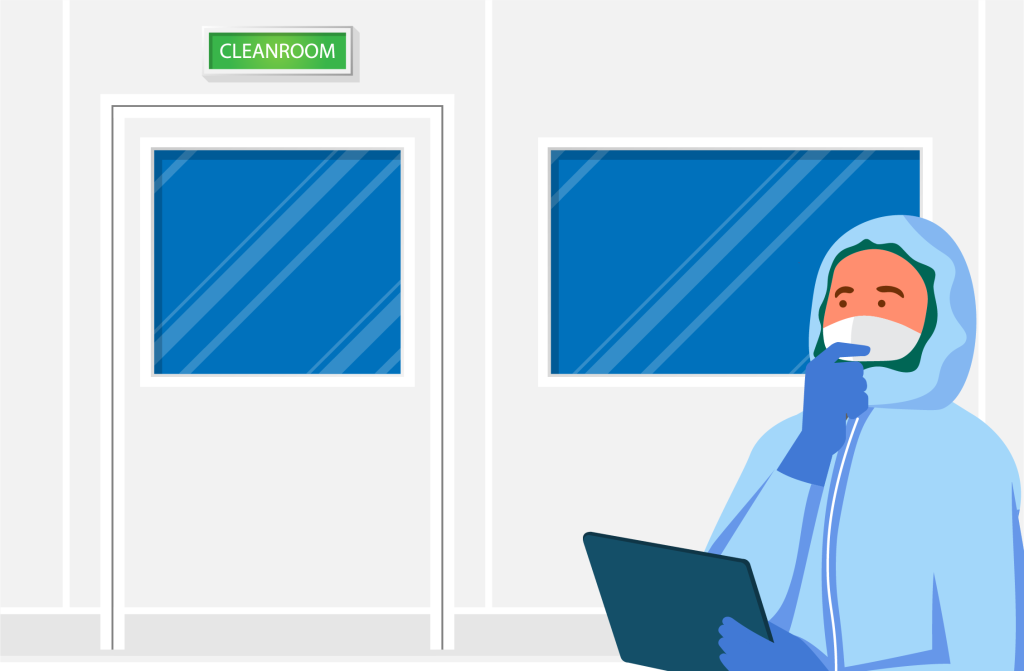How many times have you heard us say, “your cleanroom filtration is critical”? Probably more than once if you’ve spent any time interacting with us. But not all filtration is the same! Depending on your filter and application, there are different cleanroom particle filtration techniques. Today, we’ll be covering 4 of them.
Straining/Sieving
This technique is exactly what it sounds like: the filter strains particles out of the air. Similar to the way you strain water out of pasta, the filter has woven fibers that create a mesh to catch particles. Any particles that are larger than the holes are caught, while the air and smaller particles pass through.
This is the most basic type of filtration, so it works best for larger particles. It is impossible to create holes tiny and effective enough to catch the size of particles that cleanrooms need to be protected from. So this technique works best as a preliminary measure to strain out the largest particles and protect the more sensitive filters.
Inertial Impaction
Inertial impaction uses a strategic web of fibers that increase the inertia of the particles to the point they are forced out of the air stream. They then stick to these fibers and are prevented from going any further.
This technique is also used for larger particles, but not necessarily as large as the ones caught during straining. The idea is that the web of fibers speeds up the airflow to the point that the heavier particles cannot keep up. This is how they are forced out of the airstream.
Interception
Interception does just that: it intercepts the particles. It is similar to straining, except that it is designed to capture smaller particles. Instead of creating holes that catch large particles, this technique uses methods that create an attraction between the particles and fibers. The air flow carries them near enough to the fiber to be attracted and, just like that, the fiber has a hold on them.
Diffusion
Diffusion is the most complicated form of filtration technique designed to snatch up the smallest of particles. This is typically particles 0.1 microns and smaller. “Diffusion” actually describes the movement of the particles.
In this technique, air is forced upon particles until they enter a state of Brownian motion. This means they are moving randomly, bouncing back and forth and all around. By creating this chaotic motion, the filter forces them to bounce about fibers they can stick to. This drastically increases the chance they will stick to a fiber.
How To Know Which Filtration Technique Is Right For Your Cleanroom
Is there a right filtration technique for any application?
Probably not!
The best contamination control strategy involves multiple types of filtration techniques. Each one is designed to capture different types and sizes of particles, so, depending on your needs, you will probably need all 4.
Most likely, your cleanroom will need a basic straining filter at the start of your air filtration system. This would serve as a pre-filter: the filter your air goes through first. Its job is to take out the biggest particles and prolong the life of your more sensitive filters, namely your HEPA and, possibly, ULPA filters.
Depending on your cleanroom needs, you might only use HEPA filters. But if you are looking to eliminate the smallest of particles, you will most likely also need an ULPA filter.
Both of these filters use a combination of the techniques we discussed here.
So which filtration technique do you need to use?
Trick question: you need all of them, and your filter suppliers know that.

How To Make Sure Your Cleanroom Filtration Technique Is Working
What happens when you get all your filters in place and you need to know if they are working? You test for particles.
Best practice (and most certifications and classifications) require ongoing monitoring of your cleanroom. This means you have a system of particle counters in place that monitor your cleanroom 24/7, alerting you if particles outside of the set parameters are present.
But you should also regularly test the air immediately around your air filters to determine if there are any leaks in them and ensure they are working properly. Filters do clog up and wear out over time, and they need to be replaced.
Using a particle counter scanner will let you know if there are any particles outside of your determined range sneaking their way in! This could be resultant from a leak, tear, or general use.
Particle counter scanners use the same basic technology and principals as portable or remote particle counters, but they are designed to test specific spaces around filters. This means they are usually built on long handles, so you can get into hard to reach spaces.
The purpose of these scanners is obviously to test your filters, so you want to look for one that is:
- Ergonomic enough for just about anyone to handle,
- Easy to use,
- Built with a number of integration options,
- And highly sensitive to test for even the smallest of particles.
These are just a few basic ideas of what to look for in particle counter scanner to test your cleanroom filters, but the good news is that your search won’t be a long one.
The ScanAir Pro was designed by the world’s clean air experts to serve as a powerful tool in your cleanroom. You deserve the peace of mind to know that you filters are doing their job and not worn out without second guessing if your equipment is working properly. We get that. Which is why we stand behind all our particle counters with technicians, maintenance options, and constant manufacturer support – and are always seeking to set industry standards and further our technology.
Is the ScanAir Pro a fit for you? Learn more about it today.


